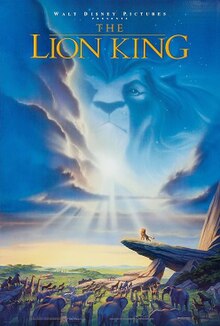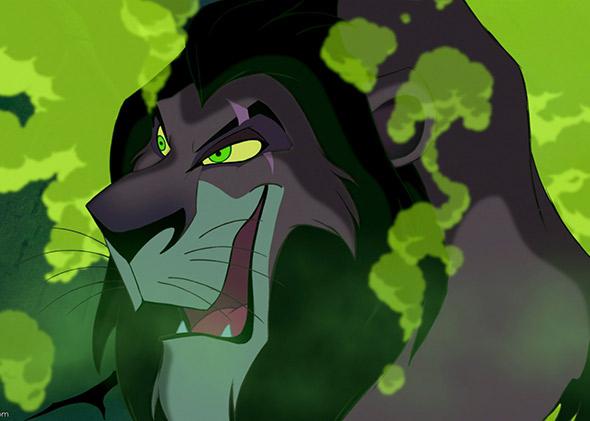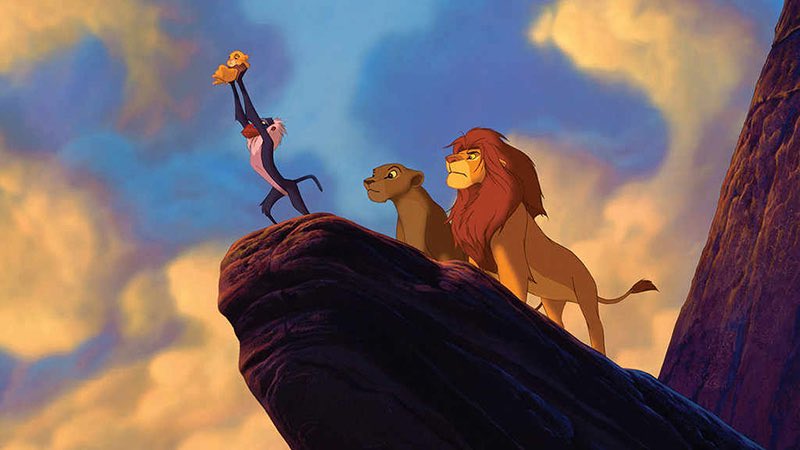King of the Pride
A Guest Post for the Riding with the Mouse Net-log by animator Andreas Deja
Of all the Disney animated features that I have worked on over the years, the one I get the most questions about is 1994’s
The Lion King. And I get why. It’s a milestone both artistically and in terms of representation. The sweeping, Williams-esque visuals are still breathtaking, if I do say so myself. The Harry Belafonte soundtrack, backed by Ladysmith Black Mambazo, is epic and unique with its African time signatures, syncopation, and chord structures.
Like this, but overtly based on the Malian Epic of Sundiata
And with its massive, legendary status today, it’s strange to imagine that it was an afterthought at the studio at the time. Compared to “big” projects of the time like
The Little Mermaid,
Treasure Planet,
The Brave Little Toaster,
Hiawatha, and even the WED Signature effort
The Hunchback of Notre Dame, it was seen as the “side hustle”, to use the modern vernacular.
And it all started as another of Jim Henson’s attempted collaborations with Japanese Anime studios.
In fact, it began as a
Kimba the White Lion remake!
With the ongoing collaborations with Studio Ghibli back in 1990, Jim wanted to collaborate with Osamu Tezuka on either Astroboy or Kimba. Since Kimba was, according to Tezuka-san, influenced by
Bambi, Tezuka Productions wanted the latter for symmetry. While working at Ghibli with us, Mike Peraza managed to get into a war with Paku-san, so Jim sent him to work with Tezuka with a side quest to finalize the Kimba deal. By this point, however, Tezuka himself had recently passed away and the studio was in a level of transitional chaos rather reminiscent of how the Old Men tell me things were at Disney when Walt died. We couldn’t come to a workable deal, so we took the ball and moved forward with our own “King of the Jungle” project, giving Tezuka and Kimba an “Inspired by” credit, which his son and heir Makoto took as “a great honor”.
But with the Kimba collaboration now “dead”, where would we take things? Well, Roy saw no reason to throw out all of the work we’d done, so we would make our own film. But what? Linda Woolverton imagined a sort of National Geographic special that covered a war between lions and baboons. Theatrical Productions VP Thomas Schumacher, who’d been ingratiating himself into Animation ever since
Aladdin and managed to become the Producer, wanted something more “Shakespearean”. Jim Henson called in his old friend and collaborator Harry Belafonte. Harry, of course, being well versed in African Lore and Legends, assumed that we were doing a production based on the
Epic of Sundiata, which told the story of the “Lion King” Sundiata Keita, founder of the Malian Empire.
He told us all the legend in his mesmerizing Griot’s voice. Thomas cried and clapped. It was as Epic as he’d hoped!
And I got to be Art Director and Storyboard co-lead alongside Brenda Chapman, while Glen Keane got to be Co-Director with Rob Minkoff after Terrell turned them down so he could continue working on
Treasure Planet.
Characters of
The Lion King (left to right): Shenzi, Soumaoro, Kicheko, Banzai, Nounfari, Young Sundiata (seated because of his shrunken back leg), Mansa (King) Maghan, Young Kolonkan, Songolon (imagine her misshapen and ugly, but kindly), Zazu, Sassouma, Mvivu, and Pumbaa. Not shown: Young Dankaran, Mkali the rhino, Mkaidi the Cape Buffalo, and Anansi the Spider. [
Note: (and for reference) adapted from the inset image
available at Wikipedia here]
We made some pragmatic changes to the epic, of course. We added new characters and modified existing ones. We merged the characters of the soothsaying hunter, Sundiata’s personal griot, and the blacksmith Nounfari into the mandril shaman/griot Nounfari, ultimately voiced by Harry. We made Kolonkan into Dankaran’s half-sister and Sundiata’s childhood friend and later love interest (and no blood relation), which was a change made from the Epic, where she is Sundiata’s sister and not a love interest (jokes about royal incest aside).
For casting, in addition to Harry as Nounfari, James Earl Jones was a natural for Sundiata’s inspiring but fallible father Mansa (King) Maghan. His beautiful but plotting first wife Sassouma was voiced by Phylicia Rashad, her conniving son (and Sundiata’s half-brother) Dankaran was voiced as a cub by Brandon Quintin Adams and as an adult by Will Smith. Dankaran’s half-sister Kolonkan (and Sundiata’s childhood friend turned love interest) was voiced by Raven-Symoné as a child and Halle Berry as an adult. Sudiata’s mother Songolon was voiced by Madge Sinclair.
Sundiata himself would, of course, be voiced by Jason Weaver as a child and by Jamie Foxx as an adult.
And the villainous lion sorcerer-king Soumaoro was brought to vicious life by the great Ving Rhames.
Mansa Soumaoro; in this case, those are clouds of sorcery as he spies remotely on Mansa Maghan (image source Slate)
Supporting this main cast, Michael Clarke Duncan and Tony Jay play Soumaoro’s henchman-enforcers Mkali the rhino and Mkaidi the Cape Buffalo. Rowan Atkinson plays Zazu, Maghan’s hornbill majordomo. Bobby McFerrin and Wayne Brady play the meerkat Mvivu and warthog Pumbaa (Brady invoking his best Satchmo). Cheech Marin and Tommy Chong were hired as the two shifty but ultimately goodhearted hyenas Shenzi and Banzai, who (along with Jim Cummings as the largely silent but ever-laughing Kicheko) teach Sundiata the plight of the “lower creatures”, generally introduced through star cameos. Vic Reeves and Bob Mortimer, for example, cameo as a pair of bickering baboons[1]. Eddie Murphy cameos as a wise-assed Zebra[2], Jaleel White cameos as an uptight Giraffe, and Nichelle Nichols cameos as an old and crusty tortoise. And finally, Whoopie Goldberg “reprises” her
Song of the South role as Anansi the Spider[3], who famously taunts Sundiata into leaving exile and taking action for himself.
Ok, so I just spent so much time talking casting. I should talk about the story!
So, first off, the Villain, the
real heart (no pun intended in
Snow White’s case!) of any Disney production! From the start it became obvious that the mercurial “first wife” Sassouma and her ambitious son Dankaran would be good proximal antagonists, but the “Big Bad” as Joss Whedon would put it had to be the villainous sorcerer-king Mansa Soumaoro. He was practically designed for Evil Menace. Like Ursula the Sea Witch, he’d be the dark force manipulating events from behind the scenes out in the spooky “Elephant’s Graveyard”, using his dark magic to spy on his rival Mansa Maghan, awaiting his chance to depose and replace him as Mansa.
But this was my first time taking lead on Storyboards, so I brought in Brenda Chapman to help with the writing and story structure. We broke the story into a three-act structure more or less using the monomyth for Sundiata, since this was an Epic, but we kept it loose, not feeling that we needed to hit all the beats with Daddy’s Sword or the Belly of the Whale and all, but just kind of keeping the general idea of a growth arc and going out into the symbolic supernatural world before returning as a changed Hero. Sundiata would be the focus, of course, but the details of his parent’s marriage and his birth would be told to him (and by extension the audience) by Nounfari in exposition so we could focus on his life rather than the events that led to it.
We decided that Sundiata would be a naïve and well-meaning child of privilege who just assumes that the world was a good place and all was in order. This would lead him to be somewhat lazy and entitled, though generally good natured, if particularly vulnerable to rejection given that his whole life, he’s been flattered due to his royal status, and is ignorant of the resentments of his fellow lions and other animals behind the scenes. He would want to just be loved and feel no need to actively change things since “all was as it should be”, and thus when denied love or faced with challenge he would retreat. His character arc would be learning that a) the world isn’t the perfect place that he thought, primarily by learning that his father and the order he maintained was less than perfect, and b) that he had to have confidence in himself and become the instrument of necessary positive change.
Nounfari presents Sundiata while Maghan and Songolon look on (Image source PBS Twitter)
So, we begin with his birth. We start the film with the epic, sweeping visuals of the kingdom, set to Ladysmith Black Mambazo’s epic and triumphant “The World Turns”, which spoke of cycles and ecosystems and the circle of life as it were (circles and cycles would be a recurring theme and motif). Maghan stands tall above the savannah, the animals celebrating him as “Mansa” as he introduces them all to his newborn son and heir Sundiata while his wife, the misshapen Songolon, looks proudly on and Nounfari leads a special ceremony. All the animals cheer, save for Sassouma and her son Dankaran, who glower, even as Sassouma’s younger daughter Kolonkan seems interested and excited in it all.
Flashing forward, Sundiata is living as the Heir Apparent, naïve and shocked and offended by any rejection. He is shown to have a shrunken rear left leg and can only hop or drag himself along, often forcing Maghan to carry him in his mouth as he shows him his kingdom, singing “Duty to the Pride” with him. Almost all of the animals genuflect to Sundiata. But Sundiata is picked on by his older half-brother Dankaran, who takes advantage of Sundiata’s smaller size and limited mobility to bully and assault him, causing most of the other lions to laugh. Only Kolonkan sticks up for Sundiata. Dankaran insists that he is the “true Mansa”, not the “crippled usurper” Sundiata with the “ugly mother”.
Goaded into following Dankaran into the Savannah to prove his “bravery and kingly virtue” (and struggling to keep up), they are accosted by the three “abhorrent” hyenas Shenzi, Banzai, and Kicheko, who laugh and say that “finally the tables are turned, eh, Kicheko?” Dankaran runs away in fear, leaving Sundiata and Kolonkan alone, seemingly to a bad fate, when his father intervenes and scares the hyenas off, loudly admonishing Sundiata for “running off”.
Humiliated, Sundiata limps away to hide. But instead, he is found by the griot and shaman Nounfari, who councils him, listens to his fears, and tells him the story of his birth. We used stylized animation based on Malian native art to tell the story of Sundiata’s birth in the flashback:
Long before, his father Maghan was wed to the beautiful but manipulative Sassouma, who bore him a son and assumed heir, the spoiled bully Dankaran. But despite having “everything”, Maghan was not content, and asked Nounfari to ask the ancestors how to make his kingdom “the greatest in the savannah.” Nounfari consulted the ancestors and told him that if he stayed with Sassouma and Dankaran became Mansa, then his kingdom would “fall to ruin”, but if he left her and married “a lioness ugly of form, but beautiful of heart” that their child would “be the greatest Mansa in all of the savannah”.
And when the ugly and deformed but kindly Songolon wandered into his domain, fleeing from the tyranny of the evil sorcerer Soumaoro, Maghan recalled the words of Nounfari and wed her. Soon she bore Sundiata. But Sundiata was born with his back leg shrunken, creating shock through the pride lands. Sassouma and Dankaran and their allies see his handicap as proof that the ancestors have cursed the cub just as they cursed the mother with her ugly form. But Maghan sees only his son Sudiata as the “true heir”.
Now for some background: these interfamily relationships are deliberately evocative of the Mande family relationship principles of the constructive “badenya” of father-and-son in contrast with the destructive “fadenya” of the rivalry of brothers, as Nounfari expresses, after th flashback, in the song “Father to Son, Brother to Brother”.
And all this time the evil Soumaoro is watching it all through his dark magic, and now makes his move. He recruits Sassouma through the duet “You Scratch my Back (I Scratch Yours)”, who plots with him to assassinate Maghan and put her son Dankaran on the throne as a subservient prince to Mansa Soumaoro. Sassouma thus tricks Sundiata into luring his father Maghan to the cliffs where Soumaoro confronts and kills him in front of Sundiata, and then Soumaoro, taunting Sundiata for leading his father to his doom (“he died by your paw, not mine!”), chases Sundiata into the path of a stampede of wildebeest. But as Sundiata appears doomed (and Soumaoro assumes him so) he is rescued by his mother Songolon , who charges into the stampede, getting kicked and knocked over, and then flees with him into exile. But she soon dies from wounds sustained from the stampede in a scene that emotionally quotes Bambi’s Mom and the fake death of Baloo
Concept Art (Image source “whatculture.com”)
Having lost everything: his parents, his kingdom, and the life that he knew, and blaming himself, Sundiata wanders the savannah, having to again run from the hyenas at one point, whom an observant viewer will note seem more content to mock him than to actually harm him. Sundiata retreats into the jungle, where he is forced to makes friends “below his station” with “prey” species like Mvivu the meercat and Pumbaa the warthog, who famously sing the Reggae-themed duet “Jamii Jamii”, essentially meaning “community of communities” and speaking of both how there’s a community for him if he wishes, but that in turn he needs to be there for the community, and that different communities need to be there for each other. This is an important concept in many African societies, according to Harry. It is a song famous for introducing the phrase Hakuna Matata, the “no worries” philosophy they follow, and it plays in comparison and contrast to “Duty to the Pride”, the juxtaposed songs using the same chord structure in opposite order and thus symbolic of Sundiata’s desire to be safe and loved contrasted with his need to take charge, fulfill his duty, and affect positive change.
It's amazing the things that you learn when working on a feature with real professionals like Brenda and Harry!
Living in exile, Sundiata is approached by Nounfari, also in exile, who builds for him a leg brace constructed from a branch of the sacred S'ra (baobab) tree, which he learns to use in a montage, aided by the comic relief Mvivu and Pumba, to learn how to walk, run, and leap and not just hop along or drag himself by his forelegs, all to the song “Pride (Stand Tall)”. He grows strong and brave, but he has also become bitter and is retreating fully into the “hakuna matata” mindset, hiding from the outside world, burying himself in the revelry of the “Jamii” and pushing aside Nounfari, who keeps trying to remind him of his destiny, and urges him to go back and fight for “what’s his birthright”. Harassed by Nounfari, he eventually storms off. Nounfari smiles, noting to Mvivu and Pumbaa that “she’ll set him straight.”
“Who?” asks Pumbaa.
Returning to the pride lands, we learn that under Soumaoro’s wicked rule, the lands have become barren as he and his pride overhunt and disrupt the natural balance in what’s played as a parable on overharvesting and other poor land management built on greed and short-term thinking. Dankaran, living in lazy abandon, a poor king and really just a puppet of the tyrannical Soumaoro, is chastised by his sister Kolonkan, who urges him to stand up to Soumaoro (“You disgrace our Mother’s memory!”), but he’s too afraid of crossing Soumaoro, and of losing his privilege. Soumaoro notices this through his magic, and sends his enforcers Mkali and Mkaidi to “trample her”, ultimately chasing her off too.
Meanwhile, in a glade by the river, Sundiata is dealing with his grief and confusion. But he’s soon taunted by Anansi the Spider, who uses her trickery and psychology to break down Sundiata’s barriers. She alludes to the way that the pride lands are in decay since “he’s so busy at the moment”. She also suggests to him that his father was not the beacon of perfection that he looked up to, learning in particular how the Lions had lived at the expense of others, bullying in particular the hyenas.
Angry with the taunts, he tries to avoid her, running through the trees and glades, but somehow, she’s everywhere, in every web. As he moves to get away from her, he encounters Kolonkan, now in exile herself, who is as amazed by both that he’s still alive (Soumaoro proclaimed him dead) and by how strong and noble he has become, while he in turn is amazed at how beautiful and graceful she has become. They fall in love to Anansi’s song “Under the Eyes of the Moon”.
Kolonkan then works to overcome his stubborn refusal to help, pleading with him and challenging his pride. As Anansi looks on, a smirk on her face, Sundiata relents, vowing to save the pride lands and reclaim his birthright. Kolonkan suggests that they need allies. Sundiata notes that he knowns just who to talk to, and leads her to the shifty Shenzi, Banzai, and Kicheko, who’ve had to resort to living on scraps (singing “A Bone to Pick”). He makes peace not just with the hyenas, but with all of the animals of the pride lands.
They reestablish contact with Nounfari and Mvivu and Pumbaa and make plans to take back the pride lands. Together in a montage they build up an army of various animals from shrews to elephants, and as they march forth (singing “All Lives, All Creatures”), Nounfari slips to the side and gives a knowing wink to Anansi.
Back at the pride lands, Sundiata challenges Dankaran for the crown. Dankaran, whose mother has apparently passed away in the intervening years, calls up the lionesses in her memory and calls on the rest of the animals to back him, but, tired of his incompetence, they all instead side with Sundiata and Kolonkan! Beset on all sides, he runs away to the elephant’s graveyard, pleading with Soumaoro for help. Soumaoro and his forces then arrive from the elephant’s graveyard, but to prevent greater bloodshed, Sundiata challenges Soumaoro to single combat. All of his friends and allies are shocked and warn him not to challenge “a sorcerer to combat”, noting in particular his handicap, but he does so anyway, with Nounfari alone assuring him that “the ancestors will protect you”.
More concept art (Image source Tumblr)
The battle is brutal and savage, and just as Soumaoro is starting to lose, he uses his dark magic to incinerate the S’ra crutch and stun Sundiata with his powers, and is soon standing over Sundiata, singing “Might makes Right” (a semi-reprise to “You Scratch my Back”) awaiting the final blow with his dark magic. But then the ghostly lion ancestors themselves, led by Mansa Maghan, appear in the clouds and intervene to block his unholy powers. Without Soumaoro’s dark sorcery, Sundiata, despite his handicap, defeats the sorcerer-king, and drives him off a cliff, where the hyenas await to finish him off in a melee in the shadows.
Nounfari declares Sundiata “Mansa”, and thus Mansa Sundiata assumes his birthright as the king of the pride lands as the assembled animals bow. Even Dankaran, Mkali, Mkaidi, and Soumaoro’s pride reluctantly come forward to bow.
Then, fast forward, in a big reprise of “The World Turns”, Sundiata stands tall over the once again lush savannah, the other beasts triumphantly celebrating him as Mansa Sundiata. They then openly celebrate when Kolokan presents her newborn son, completing the circle.
And Harry, Steve, and I got to storyboard all of that!
We did make some changes to our original storyboards as we animated, like moving the story of Sundiata’s conception to an early second act Plot Point rather than a narrated prologue to keep the flow going and to give us that epically sweeping beginning and full-circle reward at the end. Mvivu and Pumbaa were moved from the beginning to the middle, having originally been Sundiata’s “only friends” as children. We almost had Dankaran exiled, but thought that a more definitive ending was called for. We originally had Nounfari’s magic cause the S’ra branch to merge into Sundiata’s leg, healing him, similar to what happens in the original Malinke epic, but our disability advisors said that would send the wrong message. And they were right, because the disabled community still celebrates
The Lion King as an empowering tale.
So, as I mentioned up front, there was little really expected from our picture, and the original plan was for us to take the lesser summer slot and have
Treasure Planet take the coveted Holiday slot, but when the rough cuts screened Ron and Jim both agreed to reverse it! Suddenly
we were the big Holiday Epic, and we were a hit of beyond-
Aladdin-level success, breaking $400 million in North America alone, and $900 million worldwide! The Reggae-themed “Jamii Jamii” became one of the all-time Disney classic sings, as did the epic “The World Turns”.
We received accolades for representation not just for African American voice actors but for having Disney’s first African protagonists in a major animated film and our first disabled protagonist in an animated film. We won the Best Animated Picture Oscar and three Golden Globes for Best Motion Picture – Musical or Comedy, Best Original Score, and Best Original Song for “Land of the Pride”. We were very well received in Africa, in particular by the ethnic Malike, who claim Sundiata as their first great Mansa (despite the pragmatic changes), though the ethnic Sosso, who count Soumaoro as one of
their great historical Mansas, considered his portrayal a cultural insult. I guess that we should have changed the name. We still feel bad about that.
But in the end, it was for me a great moment in my life and career as an animator. Like Sundiata, nobody expected much of us, but we overcame our fears and limitations and became the King of Kings!
[1] In our timeline Cheech & Chong were the original plan for the hyenas, but Chong was unavailable. Reeves and Mortimer were strongly considered in our timeline as a pair of chipmunks, but dropped out because they disliked the Disney corporate structure.
[2] For the record I resisted the serious temptation to have Chris Rock voice the zebra, and then resisted the even darker temptation to have Will Smith’s Dankaran slap him. You’re welcome.
[3] Anansi is typically portrayed as male in most adaptions, but became “Aunt Nancy” in the US and other Anglophone nations and has made appearances as a female in some African Diaspora legends or crossed over with various Native American spider goddesses, such as the Hopi Spider Woman or Cherokee Grandmother Spider. Generally, given Anansi’s slippery ways, taking a feminine form on occasion certainly wouldn’t be out of character. It would certainly be a story to tell!









